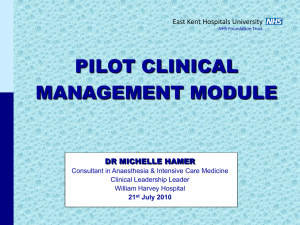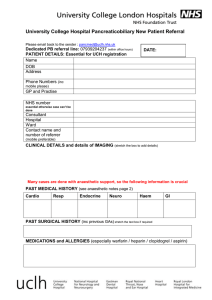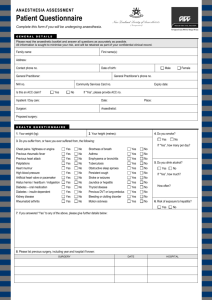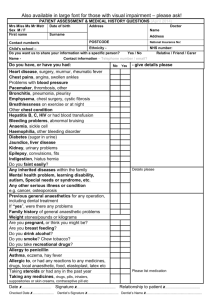trainee anaesthetic technician
advertisement
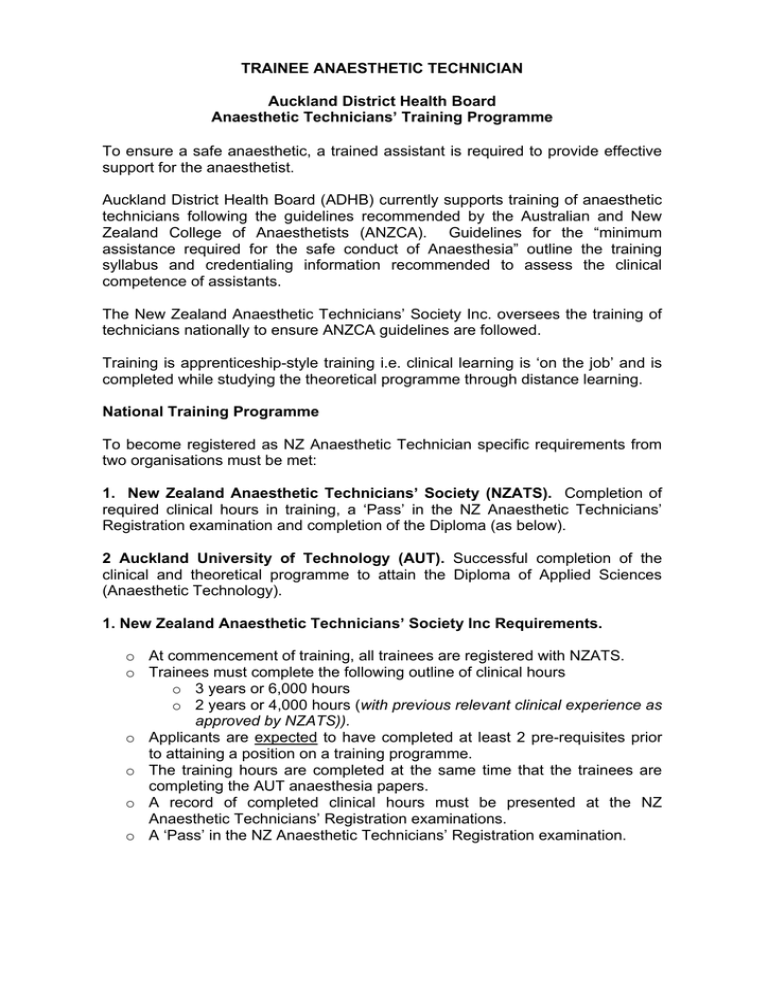
TRAINEE ANAESTHETIC TECHNICIAN Auckland District Health Board Anaesthetic Technicians’ Training Programme To ensure a safe anaesthetic, a trained assistant is required to provide effective support for the anaesthetist. Auckland District Health Board (ADHB) currently supports training of anaesthetic technicians following the guidelines recommended by the Australian and New Zealand College of Anaesthetists (ANZCA). Guidelines for the “minimum assistance required for the safe conduct of Anaesthesia” outline the training syllabus and credentialing information recommended to assess the clinical competence of assistants. The New Zealand Anaesthetic Technicians’ Society Inc. oversees the training of technicians nationally to ensure ANZCA guidelines are followed. Training is apprenticeship-style training i.e. clinical learning is ‘on the job’ and is completed while studying the theoretical programme through distance learning. National Training Programme To become registered as NZ Anaesthetic Technician specific requirements from two organisations must be met: 1. New Zealand Anaesthetic Technicians’ Society (NZATS). Completion of required clinical hours in training, a ‘Pass’ in the NZ Anaesthetic Technicians’ Registration examination and completion of the Diploma (as below). 2 Auckland University of Technology (AUT). Successful completion of the clinical and theoretical programme to attain the Diploma of Applied Sciences (Anaesthetic Technology). 1. New Zealand Anaesthetic Technicians’ Society Inc Requirements. o At commencement of training, all trainees are registered with NZATS. o Trainees must complete the following outline of clinical hours o 3 years or 6,000 hours o 2 years or 4,000 hours (with previous relevant clinical experience as approved by NZATS)). o Applicants are expected to have completed at least 2 pre-requisites prior to attaining a position on a training programme. o The training hours are completed at the same time that the trainees are completing the AUT anaesthesia papers. o A record of completed clinical hours must be presented at the NZ Anaesthetic Technicians’ Registration examinations. o A ‘Pass’ in the NZ Anaesthetic Technicians’ Registration examination. 2. Auckland University of Technology Diploma of Applied Sciences – Anaesthetic Technology The AUT provides theoretical and clinical learning programmes in distance learning papers. The papers are components of the Bachelor of Applied Science programme. Preferred pre-requisites for the Diploma are: 6th Form Certificate in Physics or AUT Biophysics Level 2 (or equivalent) Or 6th Form Mathetmatics (or equivalent) AND 7th Form Certificate in Biology or AUT Anatomy and Physiology Level 3 (or equivalent) The AUT theoretical and clinical learning modules supporting anaesthetic technician training are: Diploma in Applied Science Outline – 8 Papers Semester 1 Semester 2 Level Year 1 Anaesthesia I 5 Biophysics Anaesthetic Technology I Level 5 5 Year 2 Anatomy & Physiology I 5 Anaesthesia II 5 Year 3 Anaesthesia III Anaesthetic Technology II 6 Anaesthesia IV 7 7 Year 1 Year 3 Anaesthetic Technology I – a record of completion of clinical tasks, competencies and assessments throughout the academic year. Anaesthetic Technology II – a record of assistance in a range of surgical specialties, competencies, assessments and completion of a 2 day emergency resuscitation and airway management programme designed specifically for anaesthetic technicians. This paper is completed within academic year within the 3rd year of training On the successful completion of the listed papers the student will attain the Diploma of Applied Science, Anaesthetic Technology. ADHB Anaesthetic Training Programme This training is an apprenticeship based program working full time for 3.3 years For the first 4 weeks, trainees participate in an Induction Programme which introduces basic concepts in anaesthesia assistance and patient care. Trainees are expected to study for weekly assessments during this time. All trainees commence their clinical training programme at Greenlane Clinical Centre – for a period of 3 months. They then move to Auckland City Hospital for the remainder of their Orientation Programme. During this 6 month period, trainees are supernumerary to roster requirements and are supervised on a oneto-one basis. Trainees will also complete ADHB orientation competencies, audits and assessments in this period. On completion of the orientation programme, trainees commence clinical placements in the surgical units of the ADHB Company – o o o o Paediatric (Starship Hospital) Women’s Health (9th Floor ACH) Cardiac and ORL (4th floor ACH) Adult and Emergency Theatres (8th Floor ACH) Each placement is for several months in each hospital or unit. All trainees report to the Training & Development Coordinator but are also directly accountable to the Charge Anaesthetic Technician of the unit where they are based on a day to day basis. Training is competency, experience and task based and is supported and supervised by: o o o o Supervisor of Training (Consultant Anaesthetist) Clinical Training & Development Co-ordinator for Anaesthetic Assistance Charge Anaesthetic Technicians of each unit Trainee Technician Educator Assistance Throughout the training programme, the trainee meets regularly with the Clinical Training Co-ordinator to evaluate and monitor progress. Clinical assessments, appraisals and reviews, both formal and informal, support the training programme. During the programme both the trainee and the trainers (charge anaesthetic technicians, educators and preceptors) have the opportunity to provide feedback so any issues causing concern may be readily identified and addressed. Lectures and Tutorials Teaching time is set aside to provide instruction to support the learning process. However, completion of the AUT theoretical modules and assignments is the responsibility of the trainee and is to be done in off-duty time. AUT recommend that 10 hours additional study per week is needed to meet this requirement. AUT fees are reimbursed by ADHB when evidence of passing modules, studied whilst employed on the training scheme, is presented. Fees for the NZ Anaesthetic Technicians’ Registration examination are also reimbursed on evidence of passing. Duties You will work 40 hour weeks which may include day, evening and weekend shifts at various times during your training. You may also be required to work at least one Christmas or New Year. For the first 6 months, the trainee will usually work day duties with the preceptor. Occasionally, the trainee may accompany the preceptor on an evening shift or weekend duty. The trainee is always supernumerary to staff numbers during this orientation period. On the completion of the orientation programme, the trainee may be rostered to work afternoon shifts, and occasionally out-of-hours and weekend shifts in some of the ADHB surgical units. Currently the earliest shift start is 0700 and the latest shift end 2200. ADHB cannot guarantee that these shift times will remain the same during the course of training. During these shifts, qualified technicians will work in close proximity at all times in support of the trainee. No trainee employed on the ADHB training programme will work ‘solo’ or ‘on-call’ duties. Remuneration Trainees are paid a nominal training salary as follows (excluding NZ Registered RNs who are paid according to their year of service on the NZNO nursing scales): AT Salary Scales Year 31.6.11 1.5.13 1 31,177 31,956 2 34,009 34,859 3 36,845 37,766 4 39,678 40,670 5 42,515 43,578 6 46,056 47,207 12 61,181 62,711 1st 6 months of training then annual increments Starting salary for newly qualified AT Salaries commence at $31,177 (non-negotiable) rising to 34,009 ($34,859 after 1 May 2013) after successful completion of 6 month assessments. Progression on the scale is automatic with an annual increment. On completion of the 6 months orientation programme, overtime and penal rates for shift work will supplement income. In the last year of training the trainee can expect to be earning approximately $38,900. Nurses registered to work in NZ with a current Practicing Certificate who undertake this program will be paid at a different rate based on their years of service according to the applicable Nursing MECA and may also qualify for a reduction in the training period. Salaries for qualified technicians are also aligned to the Biomedical Technicians salary scale and is currently $46,056 for a newly qualified technician. Again, income is further supported by penal rates. Contracts All trainee anaesthetic technicians will be employed on a training contract for the duration of their training – this contract will be reviewed annually and will be renewed dependant on the trainee attaining the established clinical, theoretical, attendance and performance criteria. There will be regular performance and clinical assessments throughout the training programme. On completion of the programme, the newly registered anaesthetic technician will apply for a permanent position in the ADHB hospital or unit of their choice. The purpose of the ADHB training scheme is to ensure the highest standard of anaesthetic support to meet the service requirements of the Auckland City Hospital units. No guarantee of permanent employment is given at the completion of the ADHB training programme. All anaesthetic technicians and trainee anaesthetic technicians are employed on the collective contract of the PSA and will receive entitlements of that contract. People Skills Anaesthetic technicians must have excellent ‘people’ skills and be able to relate professionally to all groups with whom they have daily contact – in particular, patients, anaesthetists, nurses and other the team members working in the operating room environment. Environment Supports High Standard of Learning The ADHB surgical and investigative units at Auckland City Hospital, Starship and Greenlane Clinical Unit offer excellent learning environments for the trainee with the opportunity to understand the anaesthetic management of a wide range of surgical specialities. Anaesthetic technology is already a very significant speciality in the operating room environment and in other clinical areas such as Critical Care, Emergency Medicine and Investigative Radiology. With expected further development of complex procedures, monitoring and equipment and the rapid advances in technology, this is an ever-developing and exciting career, which will offer hugely satisfying rewards to successful applicants. You should also refer to the attached document “Competencies for Anaesthetic Technicians” published by the Medical Sciences Council of NZ (www.mscouncil.org.nz). This outlines the responsibilities of ATs when qualified and will give you an idea of the training goals. The above information has been complied by :Siân Mitchell RN, ATech Clinical Training and Development Co-ordinator Anaesthetic Assistance
